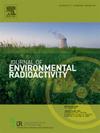No toxicity to the tropical marine microalgae Tisochrysis lutea from gamma radiation
IF 2.1
3区 环境科学与生态学
Q3 ENVIRONMENTAL SCIENCES
引用次数: 0
Abstract
Environmental risk assessments for contaminants require toxicological data to evaluate the potential effect on organisms and ecosystems of interest. As human activities in marine environments continue to intensify, so does the presence of contaminants such as Naturally Occurring Radionuclides and Radioactive Materials (NOR and NORM, respectively), and the risk of NORM contamination has risen globally through resource extraction. The FASSET radiation effects database (FRED) has compiled radiation toxicity data to collate the existing ionising radiation effect data for non-human species, leading to environmental thresholds such as the 10 μGy/h international screening level to protect 95 % of organisms in all ecosystems. However, approximately 6 % of the data used to derive this, and other, guideline levels pertain to marine organisms and may not accurately represent the sensitivities of marine species. NORM can accumulate in subsea infrastructure during oil and gas extraction and may persist in the environment during production and after decommissioning. If NORM contaminated infrastructure is left in situ, or repurposed as an artificial reef, local marine organisms may receive elevated radiation doses prior to infrastructure degradation due to the potential presence of gamma emitting radionuclides. As the impacts of radiation are not well understood for marine organisms, more relevant toxicity data is required to develop appropriate guidelines and risk assessments to ensure ecosystem protection during and after decommissioning. In this study, tropical marine microalga Tisochrysis lutea were exposed to gamma radiation from a sealed source of Cesium-137 in chronic growth inhibition toxicity assays at dose rates ranging from 0.01 to 7.9 mGy/h. Results indicated a slight hormesis response and minimal impact on the population growth of T. lutea up to the maximum tested dose rate, and the extrapolated No (Significant) Effect Concentration (N(S)EC) was 8.8 mGy/h. This is higher than environmentally relevant exposure levels and international dose rate screening levels for non-human biota, suggesting that this species is resilient to radiation exposure at these levels. Further investigation is recommended to identify more sensitive species and endpoints for radiation toxicity and that standard toxicity tests are conducted for a wider range of marine species to derive a water quality guideline for radiation.

伽玛辐射对热带海洋微藻无毒性
污染物的环境风险评估需要毒理学数据来评估对相关生物和生态系统的潜在影响。随着人类在海洋环境中的活动不断加剧,自然发生的放射性核素和放射性物质(分别为NOR和NORM)等污染物的存在也在加剧,而通过资源开采,NORM污染的风险在全球范围内有所上升。FASSET辐射效应数据库(FRED)收集了辐射毒性数据,整理了现有的非人类物种电离辐射效应数据,得出了环境阈值,如10 μGy/h的国际筛选水平,以保护所有生态系统中95%的生物。然而,用于得出这一和其他指导水平的数据中约有6%与海洋生物有关,可能无法准确代表海洋物种的敏感性。在油气开采过程中,NORM会积聚在海底基础设施中,并可能在生产和退役后持续存在于环境中。如果受NORM污染的基础设施留在原地,或重新用作人工礁,由于可能存在释放伽马的放射性核素,在基础设施退化之前,当地海洋生物可能会受到更高的辐射剂量。由于辐射对海洋生物的影响尚不清楚,因此需要更多相关的毒性数据来制定适当的准则和风险评估,以确保在退役期间和之后保护生态系统。在本研究中,热带海洋微藻在慢性生长抑制毒性试验中暴露于来自密封铯-137源的γ辐射,剂量率为0.01至7.9 mGy/h。结果表明,在最大剂量率范围内,对黄斑田鼠种群生长的刺激效应较小,外推的No (Significant)效应浓度(N(S)EC)为8.8 mGy/h。这高于对非人类生物群的环境相关照射水平和国际剂量率筛查水平,表明该物种对这些水平的辐射照射具有弹性。建议进行进一步调查,以确定更敏感的物种和辐射毒性的终点,并对范围更广的海洋物种进行标准毒性测试,以得出辐射水质准则。
本文章由计算机程序翻译,如有差异,请以英文原文为准。
求助全文
约1分钟内获得全文
求助全文
来源期刊

Journal of environmental radioactivity
环境科学-环境科学
CiteScore
4.70
自引率
13.00%
发文量
209
审稿时长
73 days
期刊介绍:
The Journal of Environmental Radioactivity provides a coherent international forum for publication of original research or review papers on any aspect of the occurrence of radioactivity in natural systems.
Relevant subject areas range from applications of environmental radionuclides as mechanistic or timescale tracers of natural processes to assessments of the radioecological or radiological effects of ambient radioactivity. Papers deal with naturally occurring nuclides or with those created and released by man through nuclear weapons manufacture and testing, energy production, fuel-cycle technology, etc. Reports on radioactivity in the oceans, sediments, rivers, lakes, groundwaters, soils, atmosphere and all divisions of the biosphere are welcomed, but these should not simply be of a monitoring nature unless the data are particularly innovative.
 求助内容:
求助内容: 应助结果提醒方式:
应助结果提醒方式:


